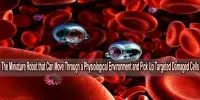Engineered living materials can combine the strength of standard construction materials with the reactivity of living systems. Microorganisms have a role in the creation of living building materials, which are also known as biological building materials.
Bacteria or other microbes operate as mini-factories in this process, producing building materials that can live, reproduce, mend fissures, and absorb harmful poisons from the air. It’s important to remember that, while wood is a biological material, it is not living.
Consider self-healing concrete, paint that changes color when a specific chemical is detected, or a substance that can replicate and fill up cracks. Construction and maintenance would be revolutionized, with far-reaching economic and environmental repercussions.
It may be some time before we see this new category of adaptive materials on store shelves. Nonetheless, important early research from the University of Minnesota offers additional insight on this fascinating innovation, which has applications beyond construction materials, including medicinal ones.
Scientists are inspired by natural solutions and species that secrete limestone, such as corals. Coral reefs, which are made up of colonies of coral polyps bound together by calcium carbonate, are one of the best examples.
The first time we saw that the bacteria and the silica were cross-linking and forming a rigid material was pivotal. At that moment, we knew it was working.
Schmidt-Dannert
Researchers from the College of Biological Sciences show how to turn silica, a common material used in plaster and other construction materials, into a self-assembling, dynamic, and robust material in a new study published in Nature Communications.
The bulk of engineered living materials now rely on incorporating a live component into the material. While this additive technique has advantages, it falls short of the ideal material of a product that develops, self-organizes, and heals.
This material has similar structural qualities to Portland cement-based mortars, with an elastic modulus of 293.9 MPa and a tensile strength of 3.6 MPa (the minimum required value for Portland-cement-based concrete is approximately 3.5 MPa).
It does, however, have a fracture energy of 170 N, which is significantly lower than most typical concrete formulations, which can have fracture energies of several kN. Other researchers were able to create a microbe that could manufacture the desired substance, but it could only survive in optimal laboratory circumstances. In real-world applications, that wouldn’t suffice.
Researchers used Bacillus subtilis, a well-studied and benign bacteria that goes dormant in unfavorable conditions and springs to life when conditions are favorable for growth, led by Claudia Schmidt-Dannert, a Distinguished McKnight Professor in the Department of Biochemistry, Molecular Biology, and Biophysics.
This property made it a good choice for future goods, which would need to be shelf-stable and simple to activate. The researchers then genetically modified the bacteria and investigated the best way to integrate it into the silica framework.
“The first time we saw that the bacteria and the silica were cross-linking and forming a rigid material was pivotal. At that moment, we knew it was working,” says Schmidt-Dannert.
The discoveries lay the groundwork for developing new engineered living materials for coatings and plasters, which are important building materials.
Schmidt-Dannert’s research team is beginning to look at new starting materials. “We’re now interested in going beyond silica, using different cells maybe even multiple cell types to develop novel engineered living materials for a range of applications.”
The research was funded by the Department of Defense Defense Advanced Research Project Agency Engineered Living Materials Program (Contract number HR0011-17-2-0038).
















